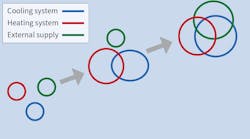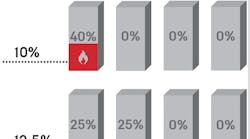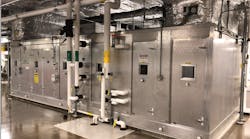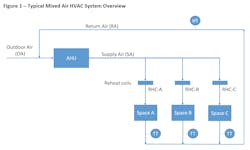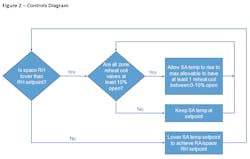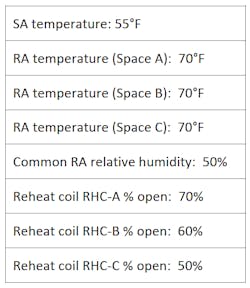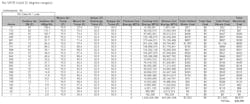By DOUGLAS EBERT, P.E., Senior Consultant Engineer, Eli Lilly & Co., Indianapolis IN
Heating, ventilation, and air conditioning systems are increasingly being scrutinized and evaluated for energy efficiency opportunities.
In the pharmaceutical industry, HVAC systems account for nearly 65% of the energy consumption of the business. This can be an incredible opportunity for energy savings. Many HVAC systems are designed with energy minimization in mind, but do not always result in being as energy efficient as intended by the design engineer. Many factors can cause this including improper controls programming, controls overrides, lack of maintenance, or improper design from the start.
Although there are many techniques for improving energy efficiency of HVAC systems, the focus of this article is a technology called Supply Air Temperature Reset (SATR). SATR is one of the easiest energy efficiency techniques to employ, assuming that the correct equipment, instrumentation and controls are in place. Depending on geographic location, SATR can be one of the most rewarding energy reduction techniques, next to shutting off an HVAC system. Energy savings of roughly 50% can be realized in applications that I have evaluated in the Midwest U.S.
The basic concept of SATR is to allow the supply air temperature to rise as much as possible but still satisfy room temperature and relative humidity set points. Many HVAC systems in office building and manufacturing applications are set up to supply a constant supply air temperature year round (typically 55°F) in order to provide comfortable relative humidity in the hot summer months and prevent mold.
Terminal reheat coils are relied upon to reheat the supply air to maintain desired space temperature setpoint. This may be adequate during the hot humid summer months, but for the remainder of the year this can be wasteful.
Consider the diagram below (Figure 1) for a typical mixed air system. The same concept also applies to once‐through (100% outdoor air) systems, except that the return air would be exhaust air. Assuming a space temperature set point of 70°F for each space, the supply air temperature would need to be several degrees lower than this to adequately cool the spaces. If the average temperature rise in the spaces due to heat gain is 5°F, then supply air no warmer than 65°F needs to be supplied to the spaces to satisfy the sensible heat load. But, the space relative humidity must also be considered. If the space relative humidity is higher than the set point, then the supply air from the AHU is not being cooled sufficiently to remove the required moisture from the air. The supply air temperature needs to be lowered. Refer to Figure 2 for the logic.
Example Case: Consider a constant volume mixed air system with 20% outdoor air and multiple zones identical to the system in Figure 1. Each zone has a temperature set point of 70°F and relative humidity set point of less than 55%. Each zone has its own reheat coil and temperature transmitter to control the reheat coil. The system status at a specific point in time is as follows:
Each zone’s temperature is satisfied. The common return relative humidity is below its maximum. Each zone reheat coil is open at least 50% as they attempt to meet the room temperature set point. The space relative humidity is satisfied by the latent heat removal at the cooling coil. This is a perfect example of overcooling the supply air only to reheat the air to satisfy the space temperature set point.
Energy is being wasted. It is analogous to driving a car with one foot on the gas and one on the brake.
The HVAC control system implementing SATR will allow the supply air temperature to rise above 55°F while at the same time satisfy the space temperature and relative humidity set points. This can be accomplished by adding programming to the control system to reset the supply air temperature set point upwards, keeping the least open reheat coil valve as close to 0% open as possible, and monitor the space temperature and relative humidity. As long as the space temperature and relative humidity are satisfied, the supply air can be allowed to rise, allowing the reheat coil control valves to close. The cooling load is reduced as well as the reheat load. This can amount to large energy savings on chilled water and heating hot water.
Energy Savings
The energy savings of a system similar to the example above can be estimated. It is impossible to predict exact annual savings by implementing SATR into a system due to varying zone conditions (e.g. number of people, equipment heat). But, by making some assumptions on space temperature rise due to heat gain an estimate for energy savings for a constant supply air temperature configuration can be calculated.
In the calculations below, the following parameters and assumptions were used:
- Supply airflow: 10,000 cfm
- Outdoor air: 20%
- System total static pressure: 6 in. WG
- Space temperature set point: 70°F
- Space maximum relative humidity: 55%
- Chilled water cost: $0.06/Ton‐Hr
- Steam cost: $1.10/Therm
- Electricity cost: $0.077/KW‐hr
- Space temperature rise (due to heat gain): 5°F
- No moisture gain or loss from the space
- Fan and motor efficiency are 75% and 95% respectively
- Bin data is derived from the 1991‐2005 typical meteorological year (TMY) data sets from the National Solar Radiation Data Base (NSRDB) archives (for Indianapolis)
- Chilled water temperature is 42°F
- Hot water reheat coils.
Below, compare the bottom lines of these two spreadsheets...
Conclusion
SATR is a powerful technology for energy savings in HVAC systems. With standard instrumentation on the HVAC system it becomes a simple controls programming change to utilize this technology. Energy savings varies by geographic location, but in the Midwest U.S., this technology pays dividends. In the example above, cooling and heating energy savings of nearly 50% is realized. The basic concept is to allow the supply air temperature to rise to maintain the least open reheat coil control valve as close to 0% open as possible while maintaining space temperature and relative humidity set points.
Based in Indianapolis, the author is a 1985 graduate of Lehigh University and now a mechanical engineer at Eli Lilly and Company in Indianapolis. In that role, he oversees the mechanical design of large capital projects and serves as an internal engineering consultant specializing in cleanroom HVAC design. He can be reached at [email protected].



